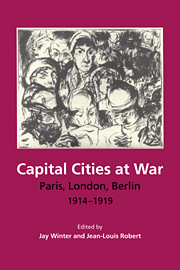Book contents
- Frontmatter
- Contents
- Note on joint authorship
- List of figures
- List of tables
- Part 1 Premises
- Part 2 The Social Relations of Sacrifice
- 3 Lost generations: the impact of military casualities on Paris, London, and Berlin
- 4 The image of the profiteere
- Part 3 The social relations of labour
- Part 4 The social relations of incomes
- Part 5 The social relations of consumption
- Part 6 Urban demography in wartime
- Part 7 Towards a social history of capital cities at war
- Statistical appendix and tables
- Bibliography
- Index
4 - The image of the profiteere
Published online by Cambridge University Press: 15 December 2009
- Frontmatter
- Contents
- Note on joint authorship
- List of figures
- List of tables
- Part 1 Premises
- Part 2 The Social Relations of Sacrifice
- 3 Lost generations: the impact of military casualities on Paris, London, and Berlin
- 4 The image of the profiteere
- Part 3 The social relations of labour
- Part 4 The social relations of incomes
- Part 5 The social relations of consumption
- Part 6 Urban demography in wartime
- Part 7 Towards a social history of capital cities at war
- Statistical appendix and tables
- Bibliography
- Index
Summary
Sacrifice was configured both as a material reality and a moral necessity. To understand it, citizens elaborated a complex moral language, which both set limits on well-being and helped define its social and individual meaning. The press helped propagate this discourse through caricature and comment. Through both we can see how decency constituted a social good even (or perhaps especially) under conditions of material deprivation. This attribute infused discussions of capabilities, duties, and entitlements in wartime, when moral exhortation was the stock in trade of the press. The first and foremost carrier of this kind of social good was the soldier, whose comportment constituted the prototype of citizenship, and on whose fortitude the well-being of the community and nation as a whole reposed.
The image of the soldier was central to the moral language of the press in the Great War. We are not concerned here with this image as a force in political debate, either patriotic, nationalist, or (from 1917) pacifist. Rather, we focus on images of right behaviour, starting with the soldier, who was at the heart of the system of values underpinning morale on the home front. Diametrically opposed to the soldier, the man of sacrifice, were those who benefited from the war without risking their hides. First and foremost here were the profiteers, people who put their personal interest over the collective destiny of the nation and of the people among whom they lived.
- Type
- Chapter
- Information
- Capital Cities at WarParis, London, Berlin 1914–1919, pp. 104 - 132Publisher: Cambridge University PressPrint publication year: 1997
- 4
- Cited by

